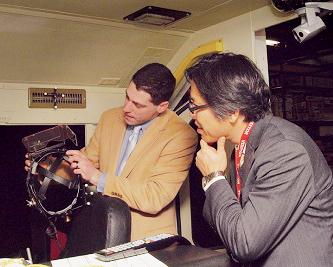Volpe Collaborates with Japanese Scientist on Rail Electromagnetic Emissions and Human Exposure
Dr. Aviva Brecher shares an interest in rail electromagnetic emissions and the impact of exposure on safety and health with Dr. Masateru Ikehata, a senior researcher with Japan's Railway Technical Research Institute (RTRI). Electric rail, like most electrical equipment that we are all exposed to in everyday life, produces electromagnetic fields (EMF) and radiation that can potentially interfere with other electrical devices, if not properly shielded, and can potentially also affect humans.
Dr. Ikehata recently visited Volpe, The National Transportation Systems Center, to discuss the development of EMF exposure standards for electric rail systems. Since they met at a bioelectromagnetics conference in the early 1990s, the two scientists have exchanged technical research findings on EMF generated by rail and magnetic levitation operations.

Dr. Brecher—Volpe's principal technical advisor on transportation safety, health, and environment—has measured and analyzed EMF emissions on German maglev trains, French TGV trains, Amtrak, commuter rail, and rail transit systems for the Federal Railroad Administration. "The issues are environmental impacts, public health impacts, and worker protection," explained Dr. Brecher. "The United States has Federal Communications Commission (FCC) regulations, but they aren't focused on transportation or the frequencies associated with power. The U.S. government needs to know what EMF intensities and frequencies pose risks in order to develop effective standards."
Developing national consensus on EMF and electromagnetic radiation (EMR) human exposure safety standards is not a simple process. Both Brecher and Ikehata have been active members of the Institute of Electrical and Electronics Engineers (IEEE) International Committee on Electromagnetic Safety (ICES).
"We currently have our own voluntary standards, but it would be best if we can harmonize with international standards," said Dr. Brecher. The World Health Organization (WHO) International Committee on Non-Ionizing Radiation (ICNIRP) human exposure safety standards differ from those issued by the U.S. IEEE/ICES which has developed and is refining broad band EMF and EMR human exposure safety standards. Brecher is currently helping the ICES update its voluntary broadband EMF and EMR human exposure standards.
"Japan's standards are almost the same as the World Health Organization's International Commission on Non-Ionizing Radiation Protection standards," says Ikehata. As part of his work on Japan's EMF safety standards, Dr. Ikehata is researching standards in other countries.
"Last year I visited Italy, France, and Britain to learn about their EMF standards," says Ikehata. "They are all different, although the European Union is trying to harmonize them." Now he is on a series of visits to study the status of EMF research in the United States. RTRI, which sponsored his visit, is jointly funded by Japan's rail industry and the Japanese government. In addition to performing basic research, RTRI promotes new technology and sustainable practices.
Above photo: Matthew Isaacs of Volpe explains findings to Dr. Masateru Ikehata from recent rail simulator research, conducted for FRA. (Volpe photo)

During his visit, Dr. Ikehata and Dr. Brecher also discussed U.S. high speed rail projects with Les Fiorenzo, FRA's Region I Administrator, and FRA's Systems Engineer Fred Mottley. (Volpe photo)
